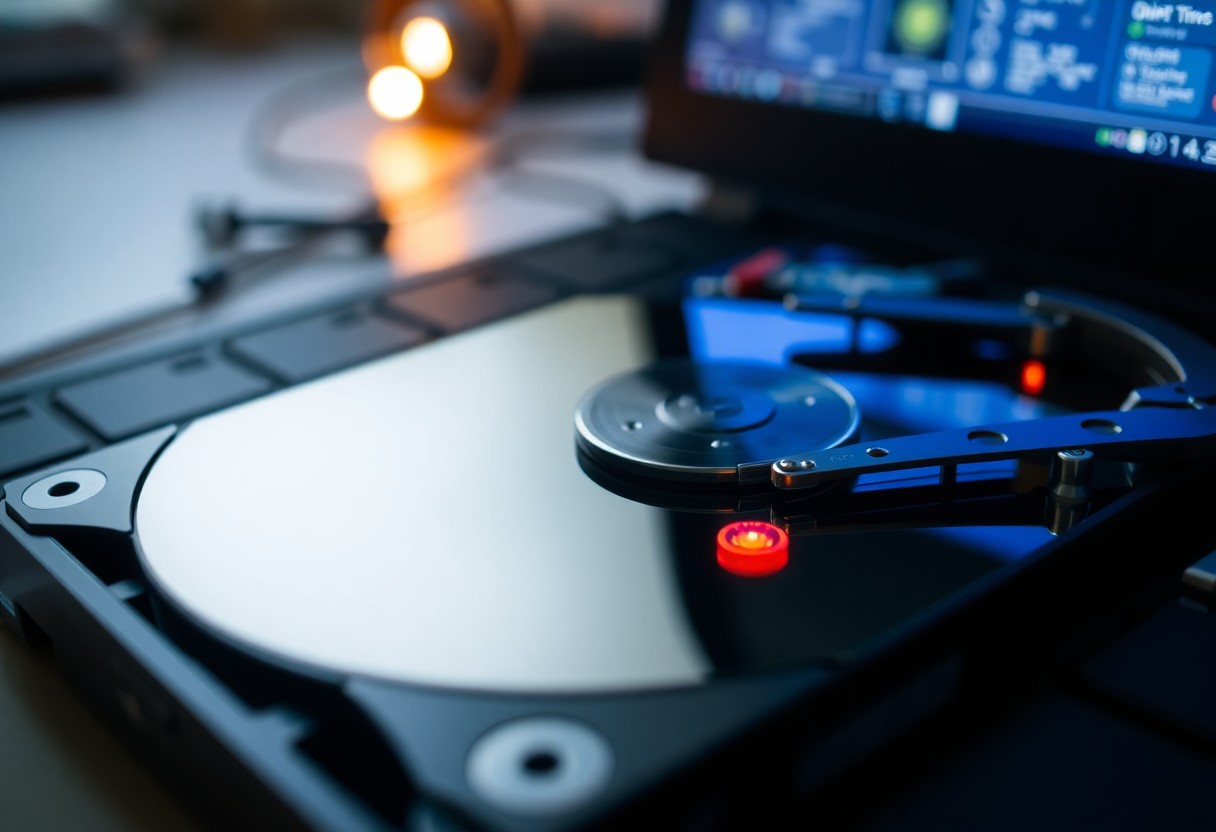There’s nothing more frustrating than losing access to your data due to a failing hard drive. Knowing the signs of failure and the tools available for diagnosis can empower you to take action before it’s too late. In this guide, you’ll learn how to identify the warning signs of a deteriorating hard drive and the necessary software tools that can help you assess its health. With the right knowledge, you can safeguard your important files and make informed decisions about repairs or replacements.
Signs of a Failing Hard Drive
To effectively identify a failing hard drive, you should be aware of several signs that may indicate potential issues. These include unusual noises, frequent crashes, and a sluggish performance. By recognizing these symptoms early, you can take preventive measures to safeguard your data and determine the next steps for recovery or replacement.
Unusual Noises
Any strange sounds emanating from your hard drive, such as clicking, grinding, or beeping, can be a serious warning sign. These noises may suggest that the drive’s read/write head is encountering problems or that the internal components are beginning to fail. If you notice these sounds, it’s advisable to back up your data immediately.
Frequent Crashes and Errors
Assuming your computer is regularly crashing or displaying error messages, it could be the result of a failing hard drive. You might face application freezes or system reboots unprovoked; these interruptions can be indicative of drive instability. Consider this a red flag and act quickly to secure your important files.
Understanding the connection between frequent crashes and a failing hard drive is key. If the drive struggles to read or write data, it can result in system instability, making your computer prone to unexpected failures. This disruption can lead to data loss if not addressed promptly, so keeping regular backups is important.
Slow Performance
Unusual sluggishness in your computer’s performance can also point to a failing hard drive. You may notice longer load times for programs or the operating system, and file transfers become frustratingly slow. This decline in efficiency can be a warning that your hard drive is losing its ability to function optimally.
Signs of a failing hard drive can be apparent through its performance. When you encounter slow speeds, it often indicates that your drive is having difficulty accessing or writing data, which may stem from physical issues or wear and tear. Regular monitoring of your drive’s health is beneficial to catch these early signs before they escalate into more significant problems.
Factors Contributing to Hard Drive Failure
While hard drives can fail for various reasons, certain factors significantly increase the likelihood of failure. Factors include:
- Age of the drive
- Heat and environmental conditions
- User usage patterns
This understanding can help you take preventive measures to prolong the lifespan of your hard drive.
Age of the Drive
Even newer hard drives are susceptible to failure over time, with most drives having a lifespan of around 3 to 5 years. As they age, mechanical parts wear down, and the risk of failure increases.
Heat and Environmental Conditions
Hard drives are sensitive to temperature and humidity, which can affect their reliability. Excessive heat can lead to component failure, while high humidity might cause corrosion.
It is vital to keep your hard drive in a well-ventilated area with a stable temperature. Avoid placing it near heat sources or in direct sunlight, as overheating can cause serious damage. Additionally, maintaining low humidity levels around your hard drive can help prevent moisture-related issues.
User Usage Patterns
Assuming your usage habits involve heavy data writing or regular defragmentation, these actions can contribute to the wear and tear on your hard drive. Frequent read and write cycles can stress the internal components and lead to early failure.
The way you utilize your hard drive can have a significant impact on its lifespan. For example, using it for heavy gaming or as a virtual machine can accelerate wear. To mitigate risks, consider spreading your workload across multiple drives or upgrading to solid-state drives for demanding applications.
How to Diagnose a Failing Hard Drive
Your hard drive is crucial for storing data, and diagnosing a failing drive is key to protecting your important files. Pay attention to signs like unusual noises, slow performance, or frequent crashes, as they can indicate impending failure. Early detection allows you to back up your data and take steps toward recovery or replacement, ensuring minimal disruption to your work and life.
Using Built-in Diagnostic Tools
Any operating system often comes with built-in diagnostic tools that can help you assess the health of your hard drive. On Windows, you can use tools like CHKDSK, while macOS provides the Disk Utility for checking disk integrity. Accessing these tools can give you a preliminary evaluation of your disk’s condition and alert you to possible issues.
Third-Party Software Options
To gain deeper insights into your hard drive’s health, consider third-party software options that specialize in disk diagnostics. These applications can provide detailed reports on your drive’s performance, temperature, and S.M.A.R.T. (Self-Monitoring, Analysis and Reporting Technology) data, allowing for proactive management of potential issues.
Diagnostic software typically offers advanced features, such as benchmarking and SMART analysis, which help you identify specific problems with your hard drive. Tools like CrystalDiskInfo and HD Tune not only reveal the current status of your drive but also monitor its health over time, offering alerts for any alarming changes. By using these applications, you can better understand your hard drive’s performance and take timely action if necessary.
Tips for Backing Up Your Data
For safeguarding your files, implementing effective backup strategies is imperative. Here are some tips to help you protect your data:
- Choose multiple backup methods.
- Schedule regular backups.
- Test your backups to ensure they work.
- Store backups in different locations.
The right approach can save your valuable information from loss.
Creating Regular Backups
There’s no substitute for regular backups when it comes to protecting your important files. Establish a consistent schedule for backups, whether daily, weekly, or monthly, depending on how frequently your data changes. This practice minimizes the risk of losing recent additions and helps maintain your data integrity.
Using Cloud Storage Solutions
On the other hand, cloud storage solutions offer a convenient and accessible way to back up your data online. You can easily sync your files and access them from various devices, keeping your imperative information safe and available even if your hardware fails.
Backups to cloud storage services provide an additional layer of security. Many cloud platforms incorporate encryption and redundancy protocols that protect your files from data loss due to hardware failure or accidental deletion. Select a reputable cloud provider, compare plans, and ensure that your data remains secure while being easily retrievable when needed.
Tools for Monitoring Hard Drive Health
All hard drives can experience performance issues over time, making it imperative to use monitoring tools that provide insights into your drive’s health. Regularly checking your hard drive can help you identify early signs of failure, allowing you to take immediate action and protect your valuable data. Various software options are available that can help you assess your drive’s status, predict failures, and ensure optimal performance.
SMART Monitoring Tools
Clearly, SMART (Self-Monitoring, Analysis, and Reporting Technology) monitoring tools are imperative for assessing the health of your hard drive. These tools leverage built-in sensors within the drive to track various performance metrics, allowing you to evaluate potential issues before they escalate. By regularly analyzing SMART data, you can make informed decisions about your drive’s longevity and take preventive measures.
Disk Health Diagnostic Utilities
Tools designed for disk health diagnostics are integral in identifying hard drive issues. They offer features like surface scans, error detection, and detailed performance reports, enabling you to thoroughly evaluate your drive’s condition. By running these utilities periodically, you can gain valuable insights into any developing problems and take action before they lead to significant data loss.
Health diagnostic utilities typically include both free and paid options that cater to different levels of expertise. Many provide user-friendly interfaces, making it easy for you to navigate and access critical information about your hard drive. Some popular tools, such as CrystalDiskInfo and HD Tune, not only help you diagnose existing problems but also monitor performance over time. Utilizing these utilities regularly will enhance your ability to maintain your drive and safeguard your data.

When to Replace Your Hard Drive
Unlike other components of your computer, a failing hard drive can lead to irreversible data loss, making timely replacement imperative. If you notice frequent crashes, unusual noises, or persistent slow performance, it’s vital to assess the health of your hard drive and consider replacement to avoid losing important files.
Signs That Replacement is Necessary
Now is the time to take action if your hard drive exhibits warning signs such as data corruption, frequent error messages, or fragmented files that refuse to defragment. Additional indicators include a marked decrease in speed during file access and unusual clicking or grinding sounds coming from the drive itself.
Options for Upgrading
Clearly, upgrading your hard drive can significantly improve your system’s performance, and you have several options based on your needs.
Understanding your upgrade options involves considering various types of drives, such as Solid State Drives (SSDs) and Hard Disk Drives (HDDs). SSDs provide faster data access, improved durability, and lower power consumption, making them ideal for enhanced performance. On the other hand, HDDs usually offer more storage space at a lower price, suitable for users with extensive data needs. Assess your requirements alongside your budget to decide which option best fits your computing lifestyle.
Conclusion
Ultimately, diagnosing a failing hard drive requires you to be attentive to warning signs and to utilize the right tools. By learning to recognize symptoms such as unusual noises, slow performance, or frequent error messages, you’ll be better equipped to address potential failures. Leveraging diagnostic software can also help you assess the health of your drive before it’s too late. Staying proactive will not only safeguard your data but also enhance your overall computing experience.



